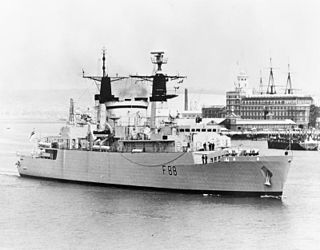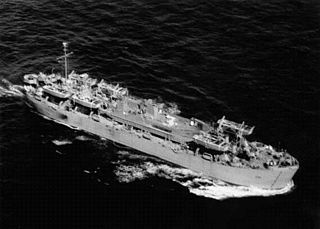
HMS Broadsword was the lead ship and first Batch 1 unit of the Type 22 frigates of the Royal Navy.

The Type 12 or Whitby-class frigates were a six-ship class of anti-submarine frigates of the Royal Navy, which entered service late in the 1950s. They were designed in the early 1950s as first-rate ocean-going convoy escorts, in the light of experience gained during World War II. At this time, the Royal Navy were designing single-role escorts and the Whitbys were designed as fast convoy escorts capable of tackling high-speed submarines. However, this made the Whitbys more expensive and sophisticated to produce in large numbers in the event of a major war, and so the Type 14 "utility" or "second-rate" anti-submarine frigate was developed to complement the Type 12. Although themselves rapidly outdated, the Type 12 proved to be an excellent basis for a series of frigate designs used by the British and Commonwealth navies for the next 20 years.

The Daphné-class submarine was a class of the diesel-electric powered submarines designed and constructed by the French defense contractor, DCNS, for the French Navy in 1964. Marketed by the French government for the export market, the Daphné design went on to serve in South Africa while there were subclasses based on the Daphné design that were commissioned in the navies of Pakistan, Portugal, and Spain.

Technical research ships were used by the United States Navy during the 1960s to gather intelligence by monitoring, recording and analyzing wireless electronic communications of nations in various parts of the world. At the time these ships were active, the mission of the ships was covert and discussion of the true mission was prohibited. The mission of the ships was publicly given as conducting research into atmospheric and communications phenomena. However, the true mission was more or less an open secret and the ships were commonly referred to as "spy ships".

The Ton class were coastal minesweepers built in the 1950s for the Royal Navy, but also used by other navies such as the South African Navy and the Royal Australian Navy. They were intended to meet the threat of seabed mines laid in shallow coastal waters, rivers, ports and harbours, a task for which the existing ocean-going minesweepers of the Algerine-class were not suited.

A helicopter carrier is a type of aircraft carrier whose primary purpose is to operate helicopters. A helicopter carrier has a large flight deck that occupies a large part of the ship, which can extend the full length of the ship like HMS Ocean of the Royal Navy (RN), or only partway, usually aft, as in the Soviet Navy's Moskva class or in the Chinese Navy's Type 0891A. It often also has a hangar deck for the storage of aircraft.

The Belgian Navy, officially the Belgian Naval Component of the Belgian Armed Forces, is the naval service of Belgium.

The Wielingen class is a class of four multi-functional frigates built for the Belgian Navy. The ships are named after sandbanks in the North Sea, not far from the Belgian coast, or sea routes. The lead ship is named after the Wielingen sandbank.

The Condell class was the name given to a class of two new build and upgraded type Leander-class frigates of the Chilean Navy, Almirante Condell and Almirante Lynch. They were ordered by the Chilean government in 1969 as ASW frigates. The ships were built between 1969 and 1973, under Chilean modifications, by Yarrow (Shipbuilders) Ltd. in Scotstoun, Glasgow. Almirante Condell arrived in Chile in 1973, with Almirante Lynch following in 1974.

USS Coconino County (LST-603), originally USS LST-603, was a United States Navy LST-542-class tank landing ship built for the United States Navy during World War II and in commission from 1944 to 1955 and from 1966 to 1969. Named after Coconino County, Arizona, she was the only U.S. Navy vessel to bear the name.

USS Dodge County (LST-722) was an LST-542 class Landing Ship Tank, built for the United States Navy during World War II. She was renamed USS Dodge County on the first of July 1955, for counties in Georgia, Minnesota, Nebraska, and Wisconsin, and was the only United States Navy vessel to bear the name.

USS Duval County (LST-758) was an LST-542-class tank landing ship built for the United States Navy during World War II. Named after counties in Florida and Texas, she was the only U.S. naval vessel to bear the name.

USS Garrett County (LST-786) was an LST-542-class tank landing ship built for the United States Navy during World War II. Named after Garrett County, Maryland, she was the only U.S. Naval vessel to bear the name.

Boltenhagen (GS09) was a Kondor I-class minesweeper built in East Germany. After the Volksmarine was disbanded just before the reunification of Germany, she was sold to Malta in 1997 and renamed P29 and was used as a patrol boat. After being decommissioned, she was scuttled as a dive site in 2007 off Ċirkewwa.
The Yurka class were a group of minesweepers built for the Soviet Navy and export customers between 1963 and 1970. The Soviet designation was Project 266 Rubin.

The Ugra class was the NATO reporting name for a group of submarine tenders built for the Soviet Navy in the late 1960s. The Soviet designation was Project 1886. One further ship, INS Amba was built for the Indian Navy to a modified design. The ships were intended to provide afloat support, including supplies, water, torpedoes, fuel, and battery charging; minimal repair facilities, and were often employed as flagships/command ships for submarine squadrons.

HMS Caicos was a Colony-class frigate of the United Kingdom that served during World War II. She was originally ordered by the United States Navy as the Tacoma-class patrol frigate USS Hannam and was transferred to the Royal Navy prior to completion. It was named after the Caicos Islands.

Pasewalk (GS05) was a Kondor I-class minesweeper built in East Germany. After the Volksmarine was disbanded just before the reunification of Germany, she was sold to Malta in 1992 and renamed P31 and was used as a patrol boat. After being decommissioned, she was scuttled as a dive site in 2009 off Comino.
















